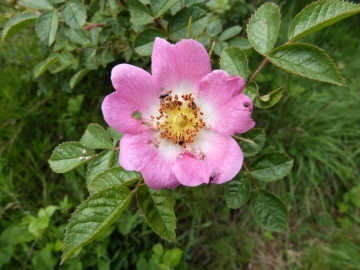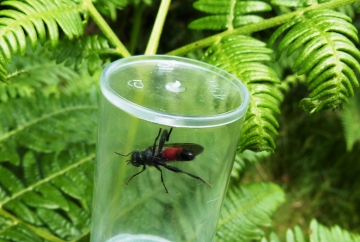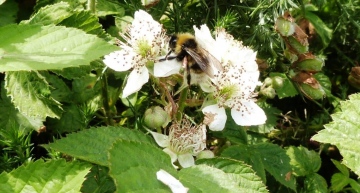We had intended to go for a walk in the nearby woodland (an extension of the Writtle Forest) but in the end we got no further than a large bramble bush on the edge of the clearing. It was the only one in bloom on the site and as, for once, the Jet Stream was kind enough to relent and allow the sun to come out, it was crowded with insects, a rare event this unsummery summer. The next two hours were spent wandering round and round this single bush and each circuit seemed to produce something new. Mark has a wonderful eye and was often picking out insects long before I could see them. He had done a lot of work on hoverflies while writing his book on Essex Parks, whereas I am only familiar with the commoner ones, and he was soon reeling off a series of Latin names; some of which I knew, most of which I had forgotten! He was on the look out for two fairly scarce Essex species whose larvae feed on dead wood and whose presence is often indicative of ancient woodland. There are five post-1990 records of the bumblebee mimic Criorhina berberina on the database (we found two colour variants)and around ten of the parasitic wasp lookalike Brachypalpoides lentus (below) including two a little further north of this site.
Among the other species on view were two more bumblebee mimics, Volucella bombylans and V. pelluscens. The former is very variable and the two colour forms we saw today were dead ringers for the Red-tailed Bumblebee and Common Carder Bee respectively. Also present was another parasitic wasp impersonator, Xylota segnis, and the social wasp mimics Helophilus pendulus and Myatropa florea.
Two Longhorn beetles whose larvae also feed on dead wood were the familar Wasp Beetle Cytus arietis and less common Rhagium mordax, the latter of which has been named the Black-spotted Pliers Support Beetle. I'm all for giving English names to insects but..............! Both these I have seen elsewhere, as I had of course the early instars of both the Dark and Speckled Bush Crickets. The Forest Shield Bug Pentatoma rufipes was also familiar. When it comes to bumblebees I am happy to identify queens of the six (nowadays seven) common garden species in spring but once the workers and drones appear they can be more problematic. Bombus hypnorum, pascuorum and pratoruum were easy enough today; so too the Cuckoo Bee, B. vestalis, but I'm less sure of Bombus hortorum as there seem to be a number of much scarcer lookalikes which probably require a scalpel to identify correctly. Heaven forbid I should ever take a scalpel to a bumblebee (parasitic wasps deserve everything they get!) so the bumblebee below is only tentatively identified as a male of this species. There seems to be a yellow band above the white tail though. As usual, I am happy to be shot down in flames by PH on this!
I am on safer ground with butterflies and moths and had no trouble with the 7 Large Skippers, male Brimstone and Brown Silver-lines and Clouded Border moths, the latter two disturbed from their daytime hideaways.
After two very enjoyable hours (passers-by explained to us that blackberries were not in fruit yet!) we retired to The Cricketers for a drink, where we found that Tree Bumblebees were nesting in the chimney!

























